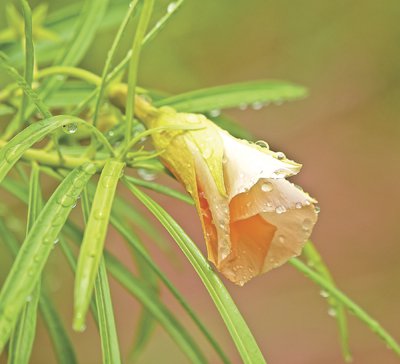Phuket Gardening: Our sunny reminders

PHUKET: Typhoon force winds, teeming torrents of rain, roads like lakes, uprooted trees and fractured boughs – hardly the conventional image of a “Land of Smiles” burnished by tropical sunshine beaming from azure heavens.
Leaden skies, accompanied by profound gloom suggest that something much more ominously potent than Venus has blotted out the sun. Despite the meteorological office’s pronouncement that such weather is normal, it is freakish rather than typical.
Our terraces and gardens were unprepared. On patios everywhere, precious potted plants have been blown over like ninepins, their containers smashed to smithereens; in garden borders, shallow rooting shrubs have lost their footholds and collapsed, even flowers that have dared to bloom in the inclement conditions are wearing a sodden and bedraggled air.
The only denizens of my patch that are genuinely thriving are the water-babes: flowering plants such as heliconias, zingibers (gingers), cannas, spider lilies, spathyphyllums and swamp lilies.
A number of foliage plants are also enjoying life, notably caladiums, marantas, climbing philodendrons, aglaonemas, and ferns such as the asplenium (bird’s nest fern).
So, all is not doom and gloom. In tropical gardens it never is. As soon as the sun returns, there will be golden blooms aplenty to remind us of the sunny days that inevitably lay ahead.
One such shrub is the allamanda, last week’s selection, a shrub whose intensely luminous golden flowers look like mini suns. Some blooms are literally hanging on, despite the storms.
Another yellow shrub that is coping better than most is the cananga odorata, sometimes known as the ylang ylang. Its unusual blooms hang down from pendulous branchlets; slim, greenish talons that change to golden as they age. The narrow, fleshy petals never open wide, but they are tough cookies, and seem more-or-less impervious to anything the weather can throw at them.
The blooms appear almost continuously amid the glossy dark green foliage, not as spectacular in appearance as the golden-trumpeted allamanda, but with the advantage of possessing a delicate fragrance that is justly famous in Thailand. Go to any spa or cosmetic department and there you will find the distinctive aroma of the ylang ylang, distilled into perfume samples, massage oils or sweet-smelling soaps.
The shrub makes a medium sized evergreen tree or large shrub, and can be trained to cover a trellis. I am aware of one ylang ylang, which covers a metal framework fully twenty feet long and ten feet wide with an overarching canopy of foliage and flowers. There is also a smaller, denser form of the shrub which grows only about two meters high. In both cases, propagation is best achieved by planting hard-wood cuttings.
Doing reasonably well in the monsoon is the yellow oleander (thevetia peruviana). Like its relative, the common oleander or nerium, it is not a fan of wet, windy conditions, but unlike the nerium it does not sulk, and stop producing its yellow or apricot, bell-shaped flowers.
Certainly there are fewer blooms than in the dry season, but thevetia is a shrub – perhaps better described as a treelet – which carries on flowering all the year round. Moreover thevetia is evergreen, and its narrow, bright green leaves are an added attraction. Because it is both striking and reliable, it has been widely planted as a roadside presence around the island.
It is also an excellent plant if you want a quick garden screen: the only drawback is that all parts are poisonous, and other smaller plants may find it difficult to grow under its canopy, especially if fallen leaves are not removed. And there are plenty of those right now.
But come rain or shine, the yellow oleander will rise above the conditions. A real survivor.
Tip of the week: Recovering from storm damage
These last few weeks have seen some of the wildest weather in years.
Trees and potted plants have been particularly hard-hit: trees because their roots have been rendered sodden and unstable by the constant rain, and their boughs and foliage
weighed down by the amount of water they have had to absorb. Add to that the wind’s ferocity and you have a deadly combination.
Particularly affected have been evergreens, heavyweight vines, and beach trees such as sea-almonds, and casuarinas. If you have a casualty or two, make a neat cut well inside the splintered wound. In that way, the tree is less liable to become infected.
Plants in containers have been toppling over like skittles. Temporarily remove their platens; which can sometimes make the pots less stable. Resist the temptation to water: they have had more than enough for the time being.
Phuket Gardening is the Phuket Gazette columnist Patrick Campbell’s feature of all things flora.
If you have a question or a garden that you would like featured, you can email Patrick Campbell here.
Keep checking our online Phuket Lifestyle pages or join our Facebook fan page for regular gardening features and tips.
— Patrick Campbell
Latest Thailand News
Follow The Thaiger on Google News:


























